This Vegan Gyros "meat" is created with Seitan, which is made from washed flour - yes, you read that correctly! Find out more on how you can turn a simple flour dough ball into delicious vegan gyros in a few steps below!
If you've tried gyros before, you'll know well how flavorsome the meat version is! It's flavored with a number of herbs and spices to give it that defining taste.
I personally used to love eating Greek food! There were plenty of greek restaurants in my hometown in Germany and my family would visit for a meal out every now and then. Gyros was always one of my favorite things to order there - sometimes as a pitta wrap, sometimes loaded onto french fries and with a generous amount of tzatziki sauce over the top... this food truly brings back memories!
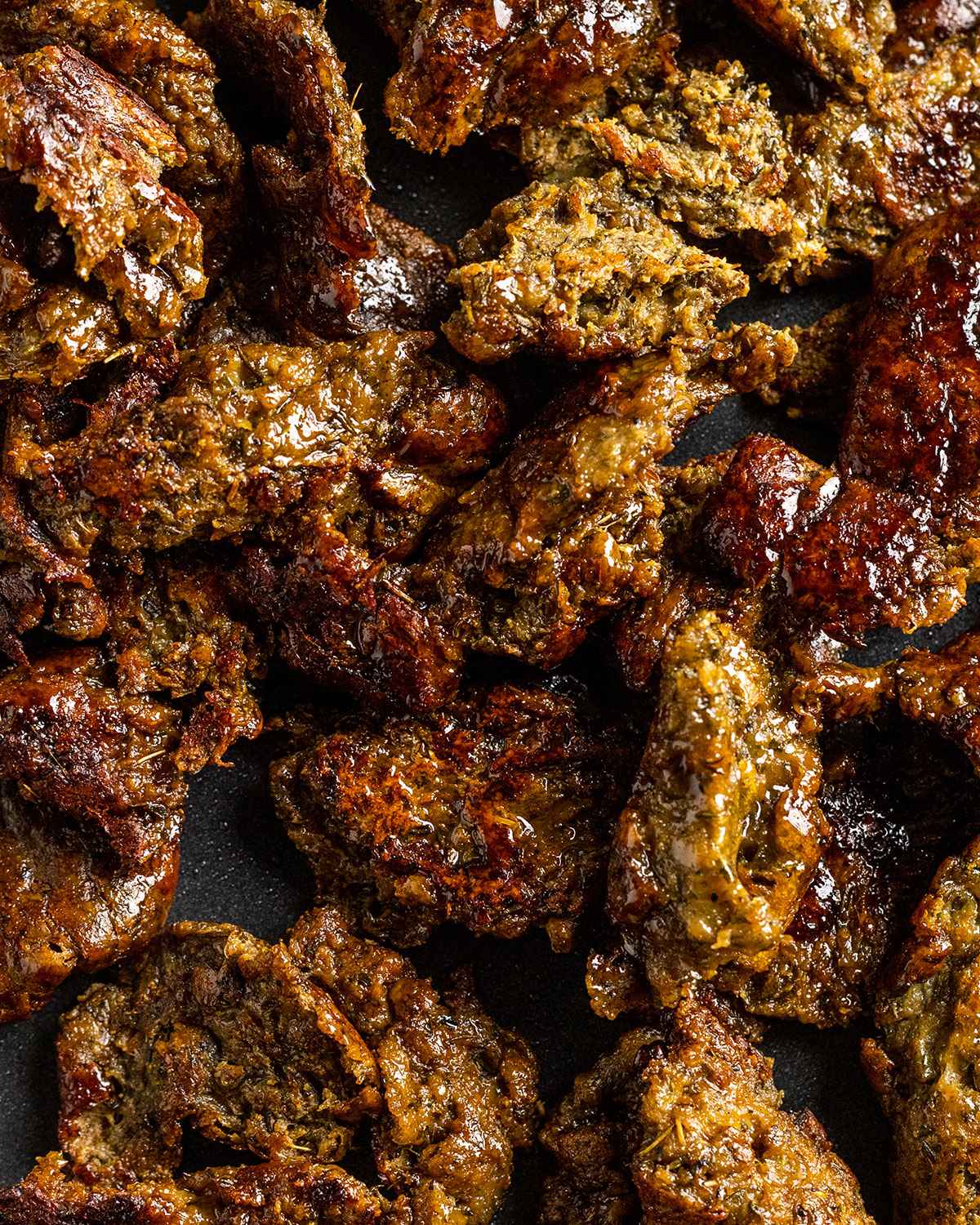
Jump to:
Why this recipe works
- it has a fantastic meaty texture
- it only uses a few ingredients
- the base is made from flour, transformed with a few simple techniques!
- the gyro seasoning is spot on!
- it's perfect to serve in a soft, warm, fluffy pita bread
- it's packed with flavor
- it's freezer-friendly and great to prepare in batches for busy weeknights
- it tastes amazing on its own as well
- it's inspired by traditional Greek-style gyros
- it's made with Seitan and just as tasty as the real thing
If you enjoy experimenting with Seitan, then check out some of my other Seitan recipes, such as Vegan Chicken, Vegan Steak and Vegan Kebab Meat.
What is Gyros?
Gyro is a seasoned meat of Greek origin, which is typically cooked on a vertical rotisserie grill and served shaved or thinly sliced. It's often stuffed and served in soft pitta bread alongside tomatoes, onions, potato chips/French fries, and a drizzly tzatziki sauce.
Traditionally, it's made with pork but also sometimes with chicken. Beef and lamb are often used as a base in other countries
Where does Gyros come from?
Whilst gyros is considered to have come from Greece, there are many similar cooking techniques that are thought to have originated in the Middle East, so it's difficult to be certain. Grilling on a vertical rotisserie was developed in Bursa around the 19th century during the Ottoman empire and called 'Doner Kebab'. Traditional Gyros uses the same technique of stacking meat in a vertical rotisserie. It is thought that immigration and population exchanges between Greece and Turkey have made the cooking technique popular around the globe after World War 2.
What is this vegan gyros made of?
This vegan gyros "meat" is made out of seitan, using the flour washing technique for the best taste and texture.
What is Seitan?
Seitan is made from wheat gluten, which is a protein found in wheat flour. It's often used in vegetarian dishes because it has a chewy texture similar to meat. Seitan has been around for thousands of years. First detected in Asian cuisines, it was used by Buddhist monks as a protein source.
How to Make Seitan
There are 2 main techniques for making Seitan: Flour-washing and using store-bought Vital Wheat Gluten. Both techniques result in different Seitan flavors and textures, you can read a little more in depth about the differences in my Vegan Steak Recipe.
For this vegan kabob recipe, we're using the flour washing technique. It is based on creating a flour & water dough ball and then washing out the starches. Please read the instructions below in detail.
Ingredients & Ingredient Notes
Here's everything you need for this recipe:
Seitan Base

Seasoning
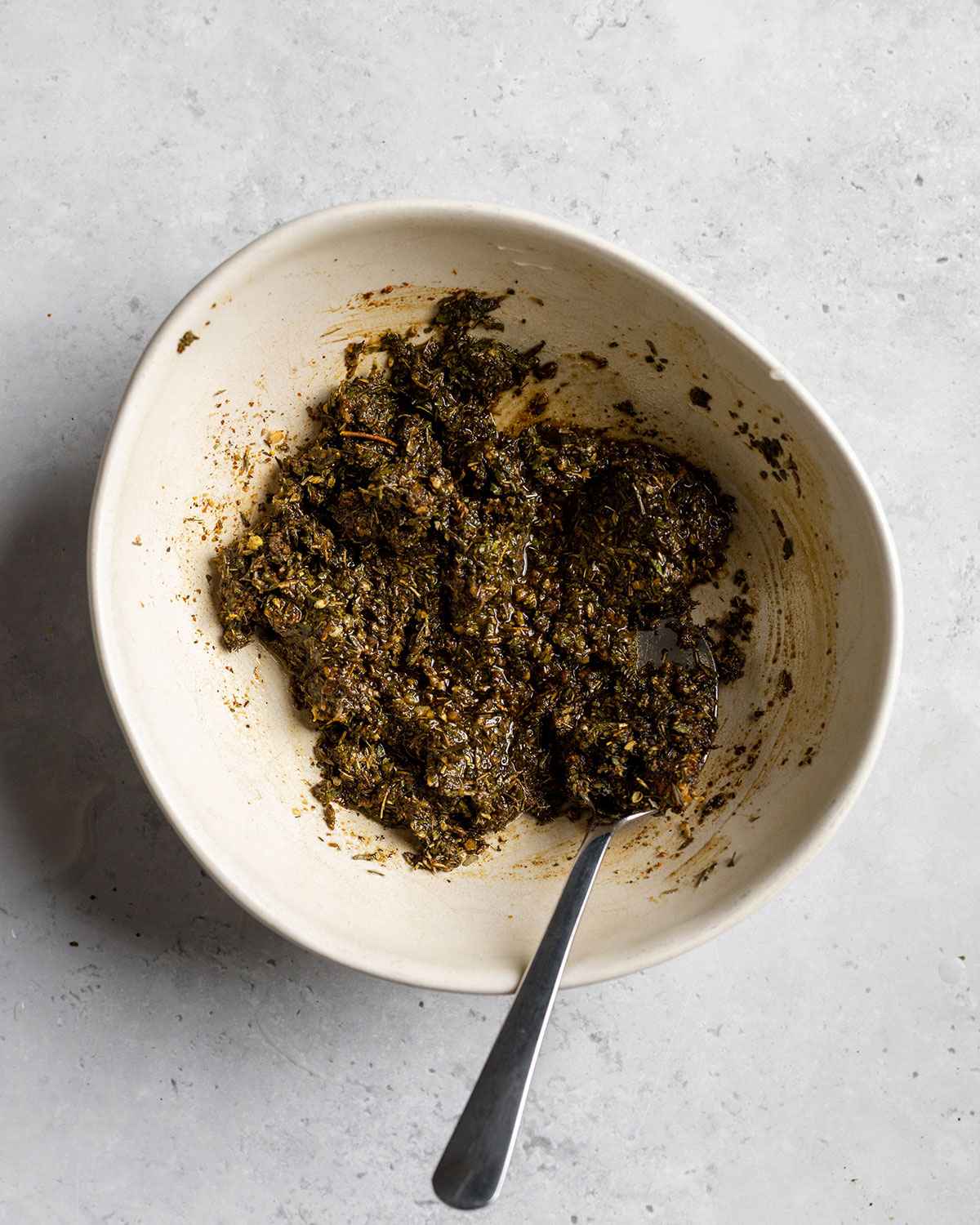
- Strong White Flour - Ideally the flour you use for Seitan should have at least 12% protein. I like to use the strong white bread flour from Allinsons.
- Water - to create a dough ball, which we will be washing later on. You also need quite a bit of water to wash the flour.
- Spices & Seasonings - Mushroom powder, black pepper, onion granules or powder, garlic powder, cumin, rosemary, oregano & marjoram
- Tamari - for brushing the gyro when grilling
- Oil - for the flavor paste & for grilling
See recipe card at the bottom of this post for full quantities.
Equipment
- 1 large mixing bowl
- 1 small bowl
- 1 food processor
- 1 grill or griddle pan
- parchment paper
- aluminum foil
Instructions (Step-by-Step)
Flour washing

In a large bowl, combine the water and flour into a dough ball.

Knead the dough ball on a lightly floured surface.
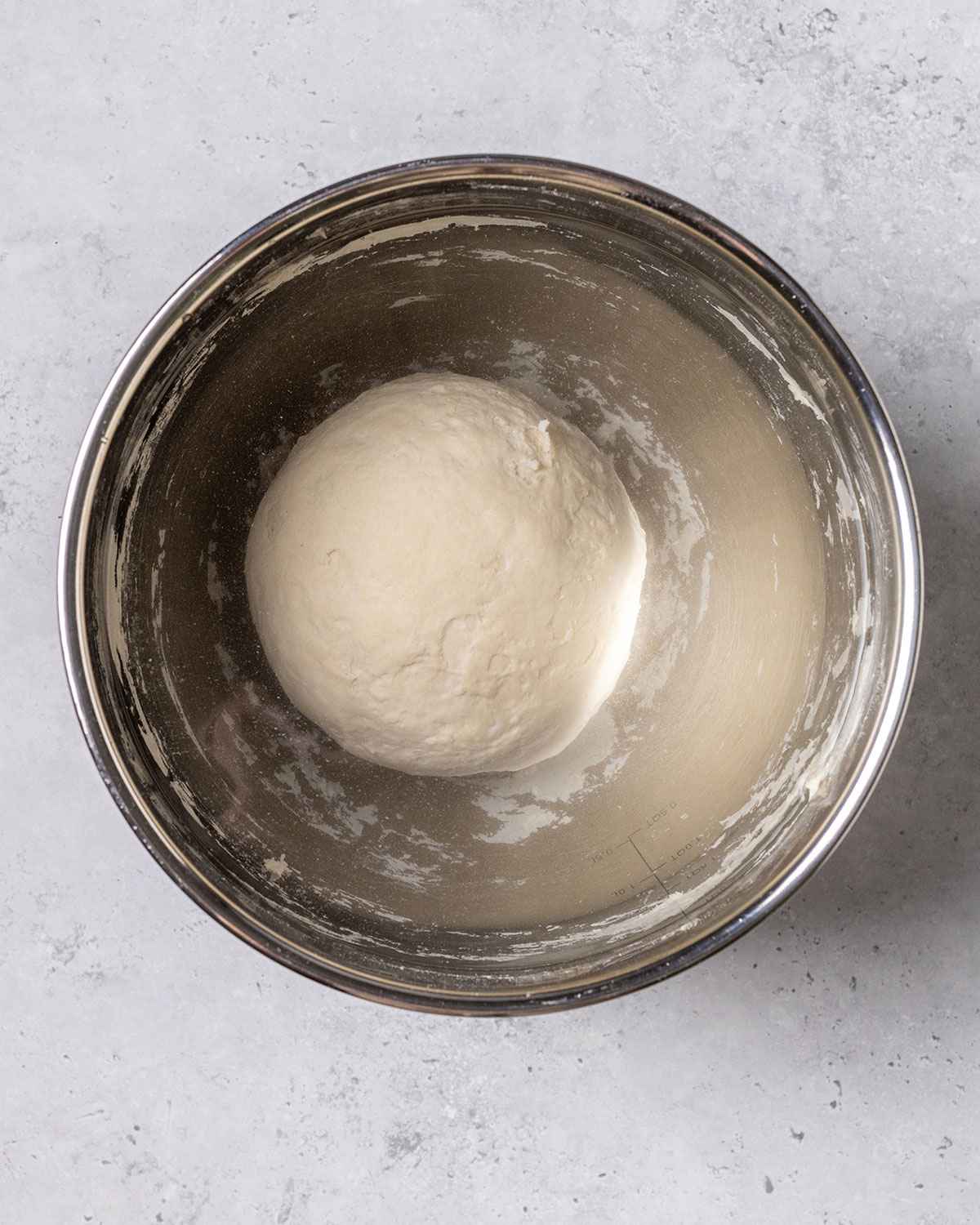
Place the dough ball back into the mixing bowl and covered it with water. Set aside for 30 minutes.
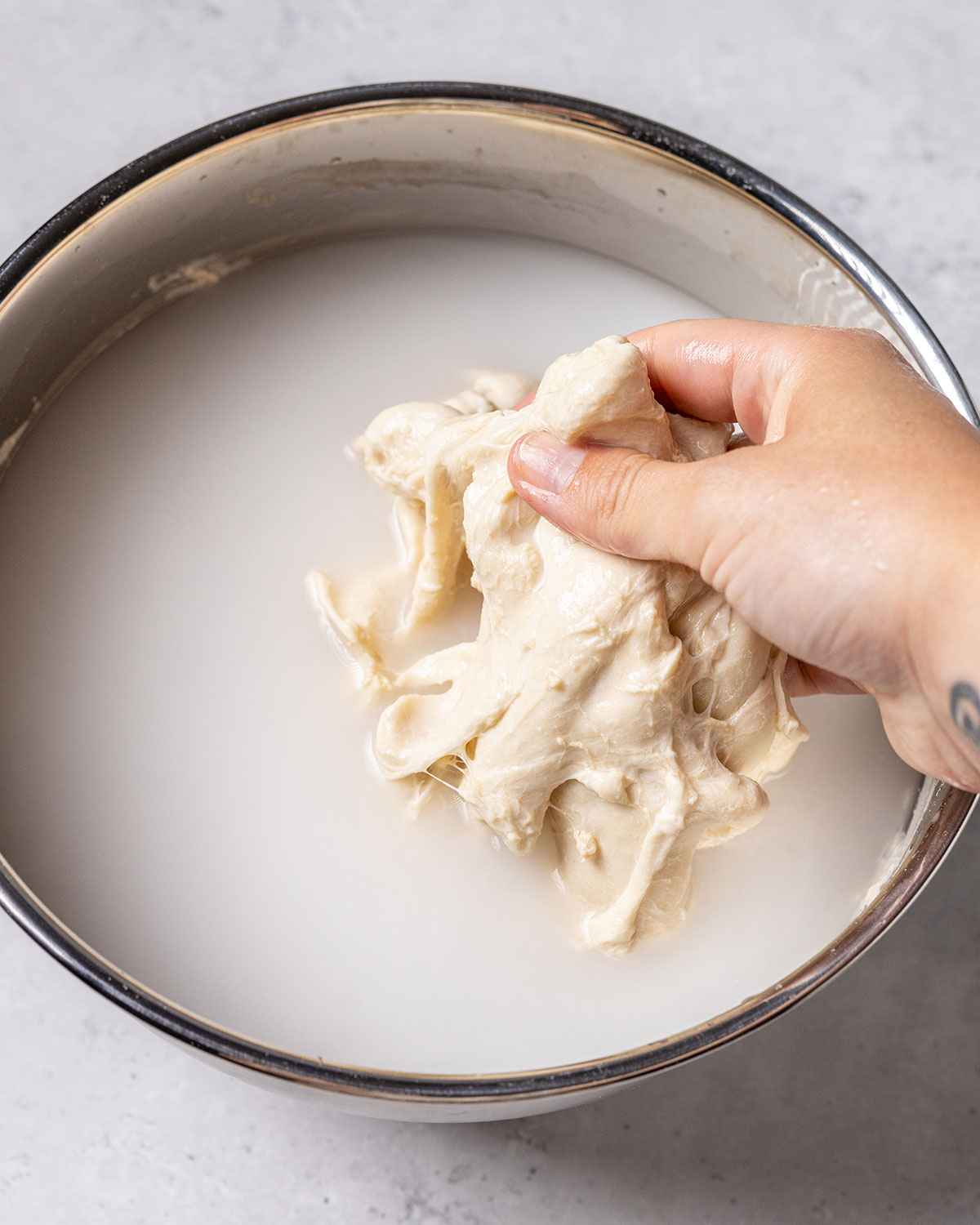
Start kneading the dough ball under water to soften. Once the water gets white and creamy, drain, add fresh water and repeat 4-5 times or until the water gets only cloudy.

Rinse the dough ball and place it into a colander to drain excess water. This is what the ball texture should look like.
Flavoring the Seitan

Combine all ingredients for the flavor paste.

Add the Seitan dough and the flavor paste to a food processor.

Pulse 5-10 times or until the Seitan and flavorings are well combined.
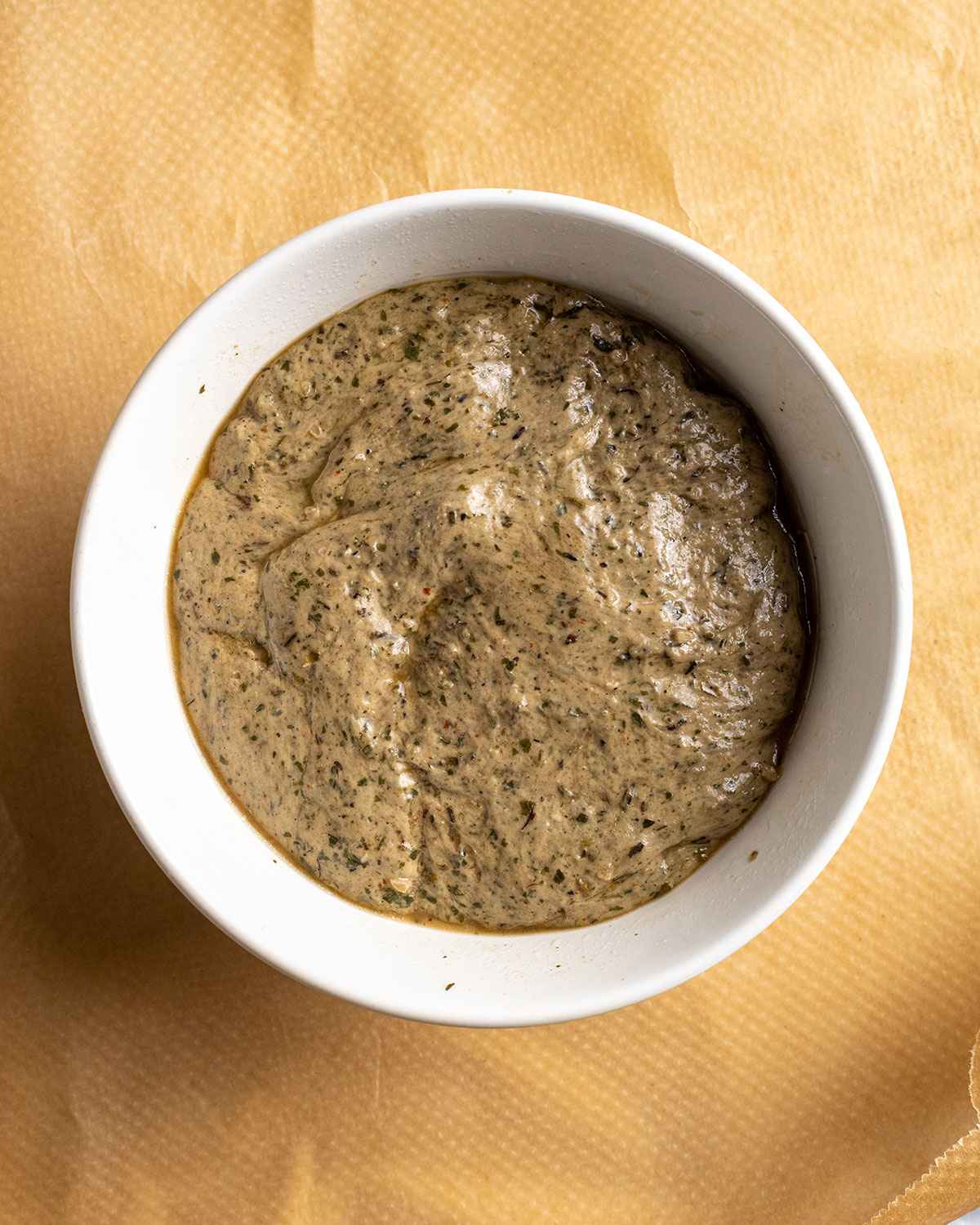
Place in a small bowl and store in the fridge for at least 2 hours or ideally over night. The texture will firm up.
Shaping & Grilling

Tightly wrap the Seitan in parchment paper and aluminum foil.
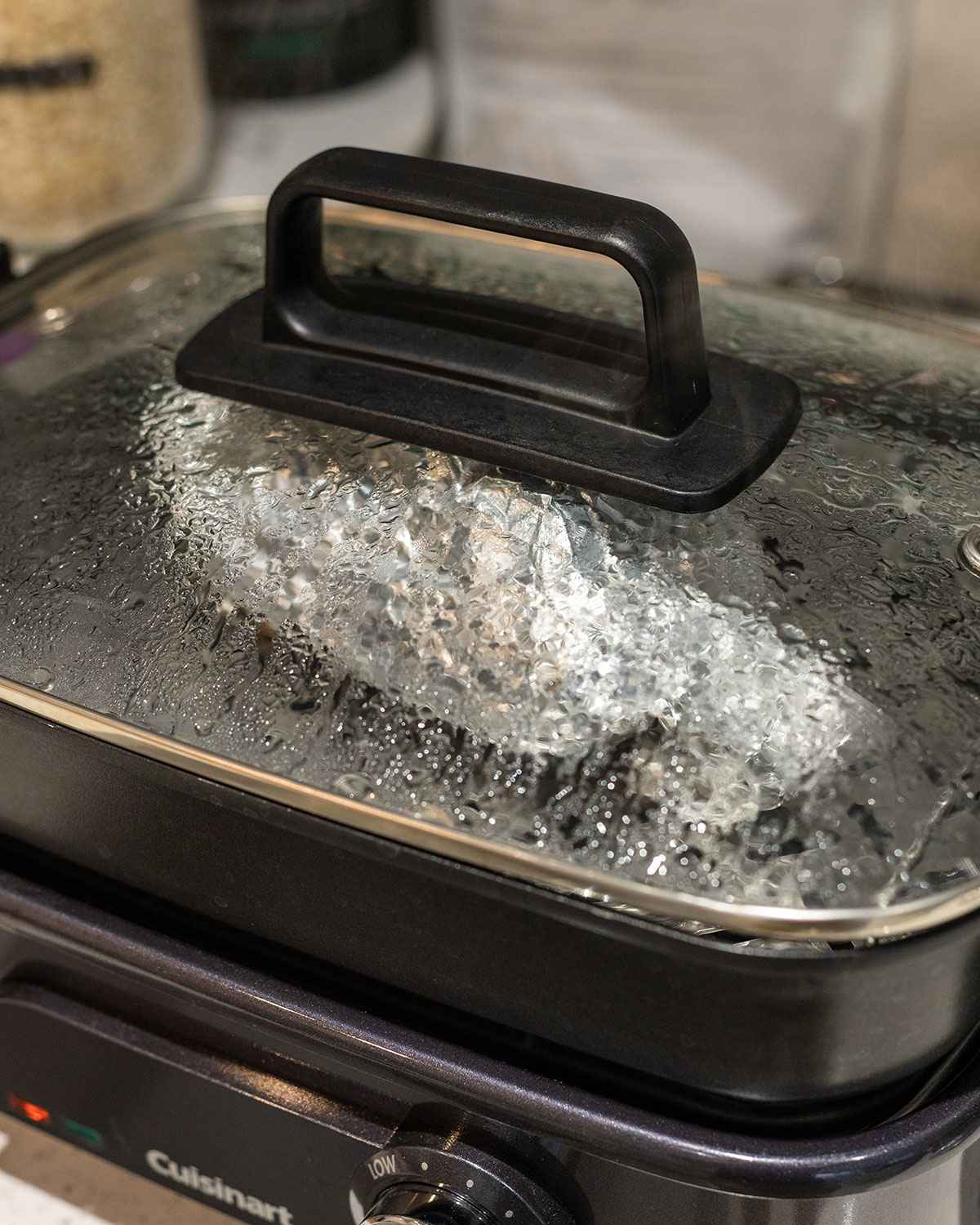
Steam the Seitan for 1 hour on medium heat.

Allow for the Seitan to cool down before carefully unwrapping.
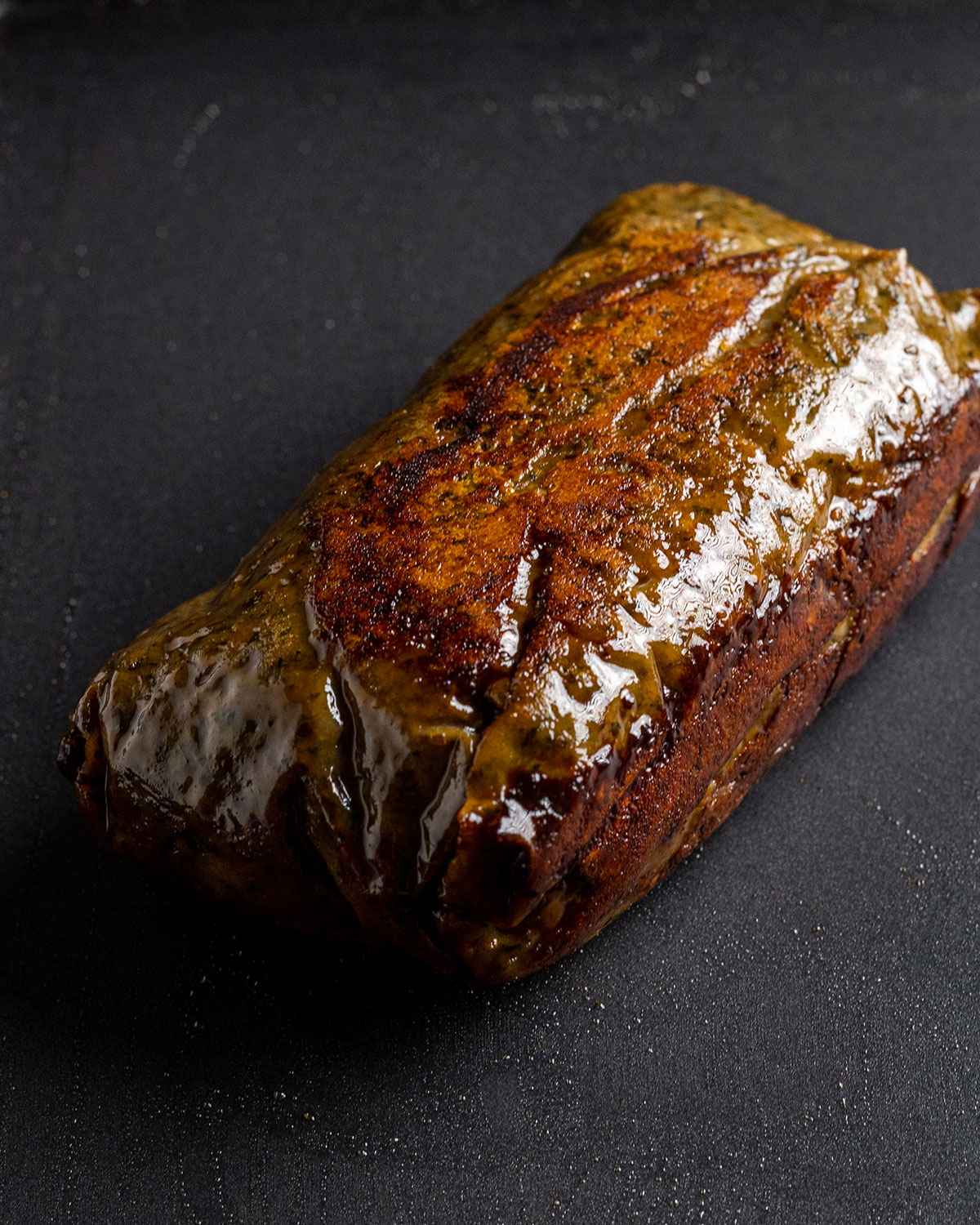
Brush with oil and tamari soya sauce and grill or pan fry the Seitan log
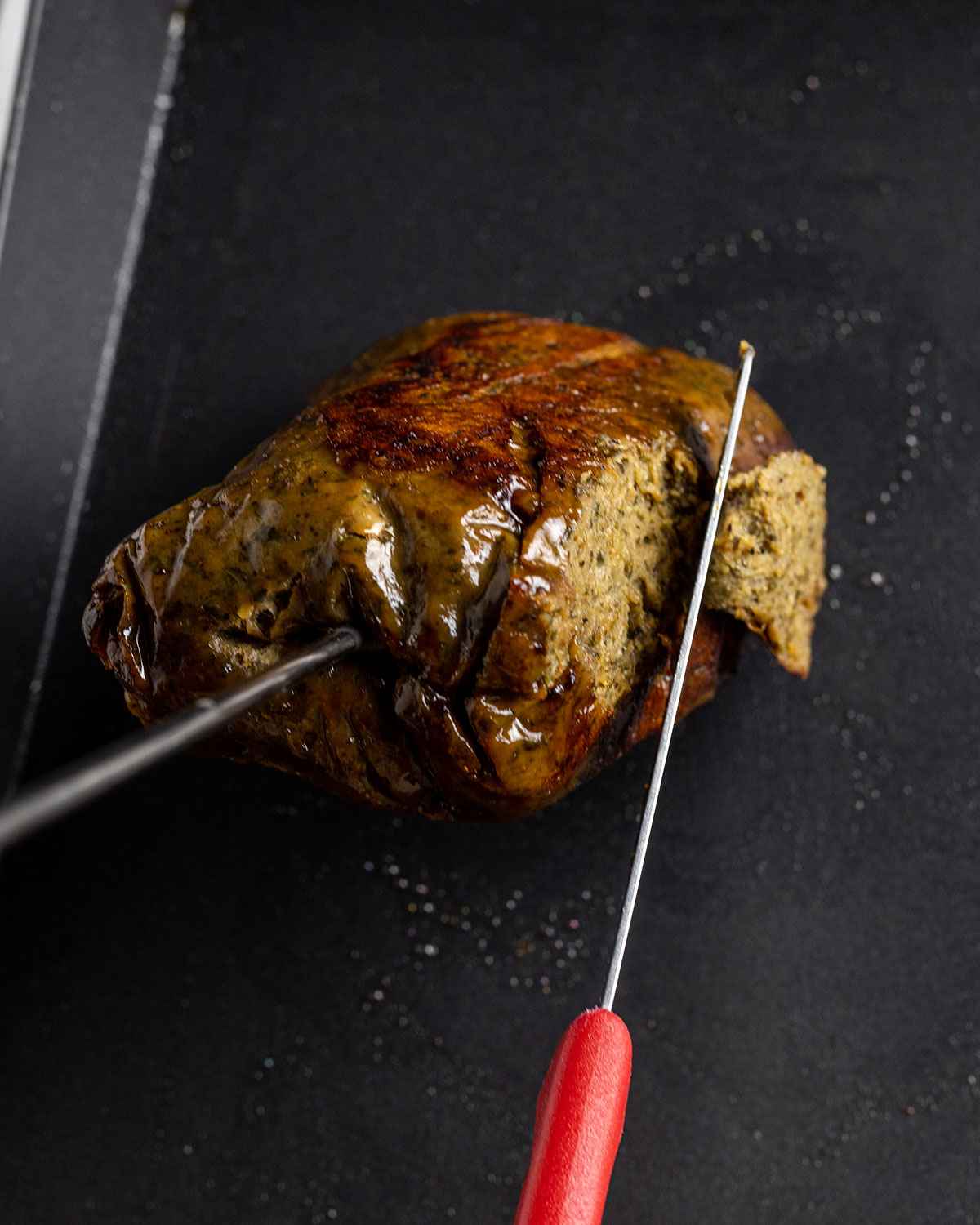
Once the outside is lightly crisp and caramelized, secure the log with a fork and shave off vegan gyro pieces with a sharp knife.

Heat or grill the gyro pieces until you get the desired texture and you're ready to serve.

Serving
This vegan gyro meat is perfect served in a warm pitta, lettuce, tomatoes, red onion, fried potatoes (aka french fries / potato chips) and drizzled with a delicious vegan homemade tzatziki sauce!
A few things you can serve with vegan and vegetarian gyros:
- fresh veggies - simply roast them on a baking sheet and serve them alongside the gyro and drizzle with vegan tzatziki sauce
- romaine lettuce - as a gyros salad bowl or in a pitta wrap
- fluffy pitta bread - homemade is always best!
- smoky roasted chickpeas - with lots of mediterranean seasonings
How to make a quick vegan tzatziki
A vegan tzatziki is super quick and easy to make! Let me show you how, in just a few simple steps.
Here's what you need:
- 1 large grated cucumber
- 2 teaspoon salt
- 350g coconut yogurt
- Juice of 1 lemon
- 2 garlic cloves, crushed
- 1 tablespoon fresh dill
To prepare the dairy-free tzatziki dip, finely shred the cucumber with a grater or a food processor, then transfer the shreds to a nut milk bag or a clean kitchen towel and squeeze out as much of the water as you can.
Transfer the cucumber shreds to a large bowl and stir in the salt, then allow it to rest for 10 minutes and squeeze out any releasing liquid again. Mix the cucumber & salt with the dairy-free yoghurt, lemon juice, garlic and fresh dill.
Storage
You can store the fried vegan gyro meat in an airtight container in the fridge for up to 3 days.
Home Freezing
Place the vegan gyro pieces into a freezer bag and store them in the freezer for up to 3 months.
Reheating
To reheat, simply defrost and briefly pan-fry the gyro pieces until the edges are lightly crispy.
Making ahead of time
If you're preparing the Seitan ahead of time, store the seasoned dough in the fridge - covered - for up to 3 days. For best results, use an air-tight container to prevent the Seitan from becoming dry. You can also store the Seitan after the steaming process for up to 3 days but what's important is to not exceed 3 days in total when making this seitan recipe.
Substitutions
To give this vegan gyro recipe the full flavor, I don't recommend making any substitutions. But here are some recommendations if you're missing an ingredient or two:
- tamari - replace tamari with dark soya sauce or coconut aminos
- black pepper - you can swap the black pepper for white pepper to create a milder version
- herbs - the herbs are important in creating the distinct flavor for the gyro. If you're missing one of them, simply leave it out, the flavor will be slightly different but still delicious.
- mushroom powder - I make my own mushroom powder by grinding dried mushrooms in a spice grinder. It's a wonderful flavor booster for all kinds of recipes, such as sauces and marinades! If you don't have dried mushrooms or powder to hand, you can also use fresh mushrooms. Simply cook 200g of chestnut or shiitake mushrooms in a dry pan until the water they release has evaporated and the mushrooms caramelized. Try to remove as much liquid as you then, then blend the mushrooms into a flavor paste with the rest of the seasonings.
Variations
- maple syrup - for deliciously caramelized edges, you can brush the pieces of gyro Seitan with a little maple syrup when pan frying. Do this towards when the gyro is almost ready to avoid the maple syrup burning.
- liquid smoke - adds a smoky flavor to the gyro, best blend ½-1 teaspoon into the flavor paste before mixing
- tomato paste - you can blend 1 tablespoon of tomato paste into the flavor paste to give the gyro a sweet tomato note
Frequently Asked Questions
This is normal! It will become super soft and shaggy and easily fall apart. It will come back together in the resting phase after blending in the flavor paste, so trust the process!
Yes, you can! You can prepare the Seitan up to 3 days ahead of time. And store it in the fridge after seasoning or after steaming.
Related Recipes
If you enjoy making homemade Seitan or similar recipes, then give these favorites from the blog a go:
If - like me - you love Pinterest, you can find me here & if you like, you can pin any of the images on this page to your boards 😊
📖 Recipe Card

Vegan Gyros (Seitan Gyros Meat)
Equipment
- 1 large mixing bowl
- 1 small bowl
- 1 food processor
- 1 grill or griddle pan
- parchment paper
- aluminum foil
Ingredients
- 2 cups strong white bread flour (500g)
- 1 cup water (237 ml) plus extra if needed
For the flavor paste:
- 2 tablespoon mushroom powder
- 1 tablespoon onion powder
- 1 teaspoon garlic powder
- ½ teaspoon black pepper
- 2 teaspoon ground cumin
- 2 teaspoon dried marjoram
- 1 teaspoon dried oregano
- 1 teaspoon dried rosemary
- 2 tablespoon tamari soy sauce
- 2 tablespoon olive oil
- a little water
Instructions
Creating the seitan base
- In a large mixing bowl, combine the flour and water into a dough ball. Knead it with your hands on a lightly floured surface for 2-3 minutes or until smooth.
- Place the dough ball back into the bowl and cover it with water. Set it aside for roughly 30 minutes.
Washing the flour
- Once the dough ball has soaked, start kneading the dough ball under water. The wheat starches will begin to dissolve into the water and the dough will become soft and loose.
- Continue to knead until the water turns white and creamy. Drain, add fresh water and repeat 4-5 times or until the water only becomes cloudy but no longer thick and creamy.
- Place the dough into a colander and rinse, then set aside for a few minutes to drain any excess liquid. It's normal for the dough to be really soft at this point, don't worry - the texture will firm up and it will come back together in the next steps.
Seasoning the dough
- In a small bowl, combine all ingredients for the flavor paste. Add a small amount of water, if needed, until you get a paste-like consistency.
- Transfer the washed dough to a food processor alongside the flavor paste. Pulse 5-10 times or until both are well combined.
- Transfer the Seitan into a bowl or airtight container and place it into the fridge for at least 2 hours or overnight. During this time the Seitan structure will firm up, creating a chewy texture.
Shaping and grilling
- Shape the dough into a log shape and firmly wrap it in parchment paper and aluminum foil.
- Steam the Seitan over medium heat in a steamer basket or steaming device. Keep the lid on to keep the moisture in. Steam the log for roughly 1 hour, then allow it to cool down slightly before carefully unwrapping it.
- Brush the Seitan gyros with oil and tamari and grill or fry it until a lightly crispy skin forms. Use a fork to hold the log in place and carefully shave off gyros pieces using a sharp knife.
- Repeat until the entire log is shaved into gyro pieces. Heat or grill the pieces until you get your desired texture and you're ready to serve!
Notes
- Serving: you can serve the homemade gyro in a soft pita alongside potato fries, tomatoes, red onion, romaine lettuce and homemade tzatziki for the ultimate gyros wrap.
- Flour: Ideally the flour you use for Seitan should have at least 12% protein. I like to use the strong white bread flour from Allinsons.
- Storage (Fridge): You can store the fried vegan gyro meat in an airtight container in the fridge for up to 3 days.
- Storage (Freezer): Place the vegan gyro pieces into a freezer bag and store them in the freezer for up to 3 months.
- Texture: It's normal for the Seitan to become very soft and almost fall apart when it's being washed properly. Don't worry, just continue with the steps and the texture will come back together and get firmer during the resting time. Trust the process!
Latest Recipes
*Disclosure: This page may contain affiliate links and sponsored links that earn me a small commission, at no additional cost to you. You can find more information in my Privacy Policy.
© 2025 Romy London / Romina Callwitz | All images, videos, wordings and content are copyright protected and belong to Romina Callwitz. Please do not use any of my content without prior permission. If you wish to re-publish any (part of my) content, please get in touch via email. Thanks for your support!
*Disclosure: This page may contain affiliate links and sponsored links that earn me a small commission, at no additional cost to you. You can find more information in my Privacy Policy.





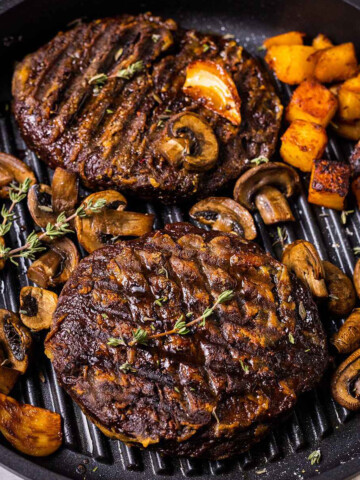
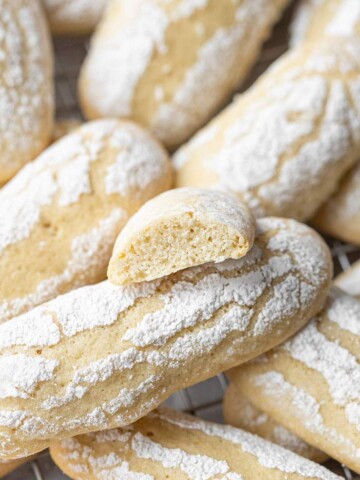


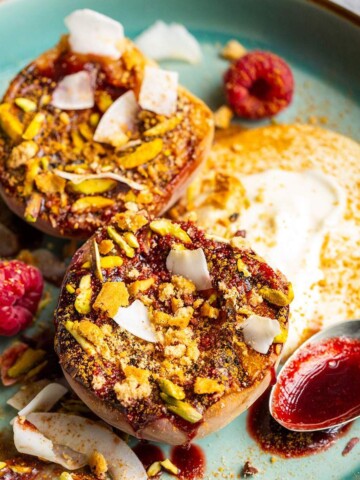




Rona
This recipe is amazing! Thank you so much for creating it! My husband is very appreciative as well. I made the gyros and the taziki sauce and we were blown away! I even over washed the flour but it still tasted amazing.
romylondonuk
So glad to hear that! Thank you so much for leaving a review 🙂
Noreen
This sounds amazing...as well as many of your other recipes. How would you adjust to use vital wheat gluten?
Romy
If you want to use vital wheat gluten, use my kebab recipe as a VWG base (just search for it as I can't drop links into comments), but swap out the kebab seasonings for the gyros ones 🙂 Hope this helps!